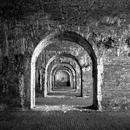Wesleyan University's Davison Art Center presents William Earle Williams exhibition September 23 through December 11, 2016

Friday, September 23 through Sunday, December 11, 2016
Opening Reception and Gallery Talk with Artist on Thursday, September 22, 2016
Middletown, Conn.—Wesleyan University's Davison Art Center presents the exhibition William Earle Williams: A Stirring Song Sung Heroic—African Americans from Slavery to Freedom, 1619 to 1865 from Friday, September 23 through Sunday, December 11, 2016. For the last three decades, William Earle Williams has traced the overlooked histories of African Americans, locating unmarked sites and photographing them with clarity and quiet elegance. This exhibition includes more than 60 photographs by Mr. Williams together with eighteenth- and nineteenth-century books, maps, newspapers, and manuscripts. Gallery hours are Tuesday through Sunday from Noon to 4pm. Gallery admission is free.
The public is invited to attend the Opening Reception and Gallery Talk on Thursday, September 22, 2016 at 5pm at the Davison Art Center, located at 301 High Street on the Wesleyan campus in Middletown, Connecticut. There will be a gallery talk at 5:30pm by photographer William Earle Williams. The opening reception is free.
The exhibition will be closed from Friday, October 21 through Tuesday, October 25; and Tuesday, November 22 through Sunday, November 27, 2016.
The exhibition was organized by the John B. Hurford '60 Center for the Arts and Humanities, Haverford College, and Lehigh University Art Galleries; and is accompanied by an exhibition catalog with an essay by Alan Trachtenberg, Neil Gray, Jr. Professor Emeritus of English and American Studies, Yale University.
Support for this exhibition at Wesleyan University was provided by the Center for African American Studies and the African American Studies Program, the Hoy Family Fund for Afro-American Art, and the Lemberg Fund.
Related Events
Thursday, October 20, 2016 from 11:50am to 1pm
Panel Discussion: A Stirring Song Sung Heroic
Russell House, 350 High Street, Middletown
FREE!
Speakers will include Lois Brown, Class of 1958 Distinguished Professor and Chair of African American Studies, and Director of the Center for African American Studies; and Demetrius Eudell, Professor of History.
Thursday, December 1, 2016 at 5pm
Virgil and Juwil Topazio Lecture:
Alan Trachtenberg, Neil Gray Jr. Professor Emeritus, English and American Studies, Yale University
Ring Family Performing Arts Hall (former CFA Hall), 287 Washington Terrace, Middletown
FREE!
About the Exhibition
Through both his research and his photographs, William Earle Williams tracks the history of African Americans from the first shipments of enslaved Africans to the many stops on the Underground Railroad, and from the battlefields of the Civil War to Emancipation. As Mr. Williams explains, the project encourages discussions about slavery and citizenship rights while broadening our understanding of how blacks participated in the Civil War.
Photographs such as Interior, Fort Morgan, Battle Site, Mobile Bay, Alabama, 2003, invite the viewer to imagine the fort during the Civil War. A number of African American sailors were on board ships in Admiral Farragut’s fleet, and African American soldiers fought in the land and sea operations for control of Mobile Bay from August 5 to August 23, 1864. Fort Morgan fell to Union forces with the loss of only one ship. An estimated 20,000 African Americans served in the Union navy during the Civil War.
More than 180,000 black Americans served in the Union Army and contributed with distinction and valor to the Union victory. Earth Works, Battle Site, Fort Pillow, Tennessee, 1999, documents the site of a massacre of African American soldiers by Confederate forces on April 12, 1864. The soldiers, who were shot while surrendering, and African American civilians, including women and children killed during the battle, were buried in a trench at Fort Pillow by Confederate soldiers. The massacre led to an investigation by the U.S. Congress Committee on the Conduct of War. Later the bodies were removed and buried in the Memphis National Cemetery. After the massacre, African American troops adopted the battle cry "Remember Fort Pillow."
This moving exhibition reveals the power of photography to bring what has been willfully forgotten or erased back to our collective consciousness. Mr. Williams summarizes his subject as "historical places in the New World from the Caribbean to North America where Americans black and white determined the meaning of freedom."
About the Artist
William Earle Williams is the Audrey A. and John L. Dusseau Professor in the Humanities, Professor of Fine Arts, and Curator of Photography at Haverford College, Pennsylvania. He received his M.F.A. in photography from Yale University School of Art and holds a B.A. in history from Hamilton College. His photographs have been exhibited at the National Gallery of Art, Smithsonian Institution, Cleveland Museum of Art, and African American Museum in Philadelphia. Mr. Williams’ photographs are in many public collections including those of the National Gallery of Art, Philadelphia Museum of Art, Baltimore Museum of Art, Brooklyn Museum, Metropolitan Museum of Art, and Smithsonian Museum of American Art. A 1997 Pew Fellow in the Arts, Mr. Williams was awarded a John Simon Guggenheim Fellowship for 2003-2004.
Images for Editors
Digital images suitable for reproduction are available in a PDF press release at http://www.wesleyan.edu/dac/press.html; for further information please contact Davison Art Center Curator Clare Rogan at (860)
685-2966 or at crogan@wesleyan.edu.
Below are the captions for those images. Please note that the images may be used only in direct connection with this press release or with other timely coverage of the exhibition it concerns.
William Earle Williams, Interior, Fort Morgan, Battle Site, Mobile Bay, Alabama, 2003, pigment print. (c) William Earle Williams.
William Earle Williams, Parker Farm, Christiana, Underground Railroad Station, Pennsylvania, 1998. (c) William Earle Williams.
William Earle Williams, Earth Works, Battle Site, Fort Pillow, Tennessee, 1999, gelatin silver print. (c) William Earle Williams.
William Earle Williams, Exterior, Slave Cabin, Oakley Plantation, Saint Francisville, Louisiana, 2004, gelatin silver print. (c) William Earle Williams.
